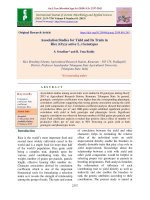Correlation coefficient and path analysis in coriander (Coriandrum sativum L.) genotypes
Bạn đang xem bản rút gọn của tài liệu. Xem và tải ngay bản đầy đủ của tài liệu tại đây (105 KB, 5 trang )
Int.J.Curr.Microbiol.App.Sci (2017) 6(6): 418-422
International Journal of Current Microbiology and Applied Sciences
ISSN: 2319-7706 Volume 6 Number 6 (2017) pp. 418-422
Journal homepage:
Original Research Article
/>
Correlation Coefficient and Path Analysis in Coriander
(Coriandrum sativum L.) Genotypes
Harishchand Ram1, Mohd. Meraj Khan1*, V.P. Pandey1 and D.K. Dwivedi2
1
Department of Vegetable Science, Narendra Deva University of Agriculture and Technology,
Kumarganj, Faizabad (U.P.), India
2
Department of Genetics and Plant Breeding, Narendra Deva University of Agriculture and
Technology, Kumarganj, Faizabad (U.P.), India
*Corresponding author
ABSTRACT
Keywords
Coriander,
Correlation
coefficient,
Path analysis
and yield.
Article Info
Accepted:
04 May 2017
Available Online:
10 June 2017
The field experiment was carried out during Rabi season of the year 2010-2011 at
Main Experiment Station (Vegetable Research Farm), Narendra Deva University
of Agriculture and Technology, (Narendra Nagar) Kumarganj, Faizabad (U.P.)
India. 110 lines of coriander germplasm maintained in All India Co-ordinated
research project on spices under Department of Vegetable Science NDUAT,
Kumarganj, Faizabad were taken for this investigation. This study revealed that
the seed yield per plot showed highly and positive significant correlation with test
weight (0.6008) followed by seed yield per plant (0.5995). The highest positive
direct effect on seed yield per plant (g) was exhibited by test weight (0.3225)
followed by secondary branches per plant (0.2292) and umbellets per umbel
(0.1087). The perusal of path coefficient analysis shown that the highest positive
direct effect on seed yield per plant (g) was exhibited by test weight (0.3225)
followed by secondary branches per plant (0.2292) and umbellets per umbel
(0.1087). Therefore, greater emphasis should be given on these characters while
selecting for higher yield and related traits.
Introduction
is extensively grown in Andhra Pradesh,
Tamil Nadu, Karnataka, Punjab, Rajasthan,
Madhya Pradesh and Uttar Pradesh. Rajasthan
is the major growing state and contributes
about 40 per cent of coriander production in
India. Coriander is an important spices and
annual herb, which is botanically known as
Coriandrum sativum L. and belong to the
family Apiaceae. Coriander leaves is used for
preparing chutneys, sauces and for curries and
soups. The seeds are extensively used as
Coriander is one of the important spices crop
grown throughout the world. It is a native of
Mediterranean region. It is grown for both
green leaves and dried seeds. In the country it
is grown on an about 543 thousand hectares
area with 524 million tonnes production and
1.0 million tonnes per hectare productivity
and in Uttar Pradesh it is grown on an about
6.68 thousand hectares area with 3.61 million
tones production and 2.6 tonnes per hectare
productivity (Anonymous, NHB, 2013-14). It
418
Int.J.Curr.Microbiol.App.Sci (2017) 6(6): 418-422
condiments and medicine. The coriander oil is
used as valuable ingredient in perfumes and
food industries. The coriander seeds are used
as spices in the preparation of curry powder
and pickling spice. They are used for
flavouring pastry, cookies-cakes, tobacco,
bakery product, meat fish, soda, syrups,
candy, preserve and liquour. Correlation and
path analysis will establishes the extent of
association between yield and its component
and also bring out the relative importance of
their direct and indirect effects and thus, gives
a clear understanding of their association with
yield. Keeping this in view, the present
investigation was done to know the
association among characters and path
analysis in coriander.
Results and Discussion
Materials and Methods
The seed yield per plot showed highly and
positive significant correlation with test
weight (0.6008) followed by seed yield per
plant (0.5995). Therefore, these characters
should be considered while making selection
for yield improvement in coriander. The days
to maturity show highly and positive
significant correlation with days to 50%
flowering (0.7887). The secondary branches
per plant showed high and positively
significant association with primary branches
(0.6425), followed by plant height (0.3393).
These findings are in line with Meena et al.,
(2014) and Sanker and Khader (1991).
Yield of a crop is the result of interaction of a
number of inter-related characters. Therefore,
selection should be done based on these
component characters after assessing their
correlation with the yield. Character
association revealed that mutual relationship
between two characters and it is important for
taking a decision regarding the nature of
selection to be followed for improvement in
the crop under study. The correlation among
the yield and yield components in coriander
are presented in table 1. The coefficient of
correlation in general was high in magnitude
indicating a strong inherent association
among various characters.
The present investigation was conducted at
Main
Experiment
Station
(Vegetable
Research Farm), Narendra Deva University of
Agriculture and Technology, (Narendra
Nagar) Kumarganj, Faizabad (U.P.) India,
during Rabi season of 2010-11. 110 lines of
coriander germplasm maintained in All India
Co-ordinated research project on spices under
Department of Vegetable Science NDUAT,
Kumarganj, Faizabad were taken for this
investigation. These genotypes were collected
from different places of India.
Test weight showed positive correlation with
seed yield per plant (0.3936). Similar results
were also reported by Sanjeev et al., (1990).
Yield is the sum total of the several
component characters which directly or
indirectly contributed to it. The information
derived from the correlation studies indicated
only mutual association among the characters.
Whereas, path coefficient analysis helps in
understanding the magnitude of direct and
indirect contribution of each character on the
dependent characters like seed yield.
The experiment was conducted in Augmented
Block Design. Seed were sown in line by
maintaining 40 x 20 cm plant spacing during
first week of November. All the
recommended cultural practices were
followed to raise good crop. The observations
were recorded on five selected plants of each
row. The simple correlations between
different characters were estimated according
to Searle (1961) and path coefficient analysis
was carried out according to Dewey and Lu
(1959).
419
Int.J.Curr.Microbiol.App.Sci (2017) 6(6): 418-422
Table.1 Estimates of simple correlation coefficient among different characters in coriander
S. No.
Character
1
Days to 50% flowering
2
Plant height (cm)
3
Primary branches/ plant
4
Secondary branches/ plant
5
Days to maturity
6
Umbels/ plant
7
Umbellets/ umbel
8
Seeds/ umbel
9
Test weight (g)
10
Seed yield/ plant (g)
11
Seed yield/ plot (Kg)
Days to
50%
flowering
1.0000
Plant
height
(cm)
Primary
branches/
Plant
Secondary
branches/
plant
Days to
maturity
Umbels/
plant
0.0202
-0.0368
-0.0272
0.7887 **
0.2932
0.3393
0.6425 **
1.0000
1.0000
1.0000
Umbellets/
umbel
Seeds/
umbel
Test
weight
(g)
Seed
yield/
plant (g)
Seed
yield/ plot
(Kg)
-0.0405
-0.0942
0.0973
0.0714
-0.0510
-0.0010
0.0349
0.1454
0.2441
0.0614
0.0938
0.1379
0.0062
-0.0179
0.1890
0.2796
0.1759
0.0886
0.0976
0.0004
-0.0115
0.1547
0.2966
0.1264
0.1118
0.2371
0.1625
-0.0555
-0.0435
0.0676
0.0396
-0.0271
0.0167
0.2591
0.0720
0.3003
0.1447
0.1288
1.0000
0.0695
0.2853
0.2549
0.3194
1.0000
0.3134
0.1962
0.2727
0.3936
0.6008 **
1.0000
0.5995 **
1.0000
1.0000
1.0000
1.0000
420
Int.J.Curr.Microbiol.App.Sci (2017) 6(6): 418-422
Table.2 Direct and indirect effect of different characters on seed yield of coriander
S. No.
Character
Days to
50%
flowering
Plant
height
(cm)
Primary
branches/
plant
Secondary
branches/
plant
Days to
maturity
Umbels/ Umbellets/
plant
umbel
Seeds/
umbel
Test
weight (g)
Seeds
yield/
plant (g)
1
Days to 50%
flowering
-0.1029
-0.0021
0.0038
0.0028
-0.0812
0.0042
0.0097
-0.0100
-0.0073
-0.0510
2
Plant height (cm)
0.0011
0.0525
0.0154
0.0178
0.0018
0.0076
0.0128
-0.0032
0.0049
0.1379
0.0053
-0.0419
-0.1428
-0.0917
0.0026
-0.0270
-0.0399
-0.0251
-0.0127
0.0976
-0.0062
0.0778
0.1473
0.2292
-0.0026
0.0355
0.0680
0.0290
0.0256
0.2371
3
4
Primary branches/
plant
Secondary branches/
plant
5
Days to maturity
0.0296
0.0013
-0.0007
-0.0004
0.0376
-0.0021
-0.0016
0.0025
0.0015
-0.0271
6
Umbels/ plant
0.0002
-0.0008
-0.0010
-0.0008
0.0003
-0.0053
-0.0014
-0.0004
-0.0016
0.1447
7
Umbellets/ umbel
-0.0102
0.0265
0.0304
0.0322
-0.0047
0.0282
0.1087
0.0076
0.0310
0.2549
8
Seeds/ umbel
0.0092
-0.0058
0.0167
0.0120
0.0064
0.0068
0.0066
0.0948
0.0297
0.1962
9
Test weight (g)
0.0230
0.0303
0.0286
0.0360
0.0128
0.0968
0.0920
0.1011
0.3225
0.3936
RESIDUAL EFFECT = 0.8807 diagonal values are direct effects; above and below diagonal are indirect effects.
421
Int.J.Curr.Microbiol.App.Sci (2017) 6(6): 418-422
Coriander (Coriandrum sativum L.).
Horticulture Journal, 19: 65-67.
Dewey, D.R. and Lu, K.H. 1959. A correlation
and path analysis of components of crusted
wheat grass seed production. Agron. J., 5:
515-518.
Jain, U.K. and Singh, D. Amrita 2003. Correlation
and path analysis for certain metric trails in
coriander. Progressive Agriculture, 3(1):
86-88.
Kumar, S. 1997. Genetic Variability in coriander,
M.Sc. (Ag.) Thesis, Deptt. Of Hort. (Veg.
& Flori.), RAU, Pusa, Samastipur (Bihar).
Meena, R.S., Kakani, R.K., Chaudhary, S., Singh,
B. and Panwar Alka 2014. Genetic diversity
analysis in coriander (Coriandrum sativum)
varieties. 3rd International Conference on
Agriculture & Horticulture held at
Hyderabad
International
Convention
Centre, India October, 27-29, 2014.
Sanjeev, A., Sharma, R.K. and Agrawal, S. 1990.
Quality evaluation in coriander. Indian
Cocoa arecanut and Spices Journal, 13(4):
137-138.
Sankar, K B. and Khader, M A. 1991. Studies on
genetic Variability in coriander. South
Indian Horticulture, 39: 312-14.
Searle, S.R. 1961. Phenotypic, genotypic and
environmental correlations, Biometrics, 17:
474-480.
Srivastava, S.B.L., Tripathi, S. M. and Srivastava,
J.P. 2000. Genetic divergene in coriander
(Coriandrum sativum L.). Spices and
Aromatic
plant:
Challenges
and
opportunities in the new century
Contributory
papers.
Centennial
Conference on spices and aromatic plant,
Calicut, Kerala, India, 20-23 September,
2000. 68-70.
Vedamuthu, P.G.B., Khader, M.A. and Rajan,
F.S. 1989. Yield components in coriander.
South Indian Horticulture, 37 (5): 287-290.
Partitioning of correlation coefficient into
direct and indirect effects provide information
about the nature and magnitude of effects of
other characters on seed yield. The result of
the present investigation on path coefficient
analysis as presented in table 2 revealed that
the highest positive direct effect on seed yield
per plant (g) was exhibited by test weight
(0.3225) followed by secondary branches per
plant (0.2292) and umbellets per umbel
(0.1087). These indicate that seed yield could
be improved by making selection on the basis
these characters. These findings are in
agreement with Datta et al., (2006), Kumar
(1997), Vedamuthu et al., (1989), Choudhary
(1987), Jain et al., (2003), Srivastava et al.,
(2000) and Srivastava et al., (2000).
Path coefficient analysis indicated that utility
of the character like test weight (g) which
showed highest positive direct effects on seed
yield per plant. These are major yield
contributing traits for enhancing the yield of
coriander. From the above study it is
concluded that test weight, secondary
branches per plant and umbellets per umbel
should be given more emphasis in the
selection aimed at improving seed yield per
plant in coriander.
References
Anonymous 2014-15. National Horticulture
Board, data base.
Choudhary, C.L. 1987. Association of
developmental characters with grain yield
in coriander (Coriander sativum L.). M.Sc.
(Ag.)
Thesis, Sukhadia
University,
Udaipure, Campus-Jobner.
Datta, S., Chatterjee R. and Satya 2006.
Correlation and path analysis studies on
How to cite this article:
Harishchand Ram, Mohd. Meraj Khan, V.P. Pandey and Dwivedi, D.K. 2017. Correlation
Coefficient and Path Analysis in Coriander (Coriandrum sativum L.) Genotypes.
Int.J.Curr.Microbiol.App.Sci. 6(6): 418-422. doi: />
422
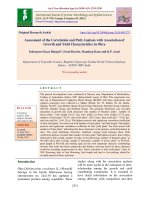

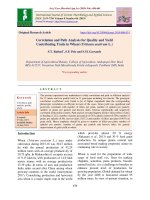
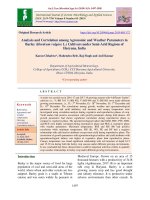
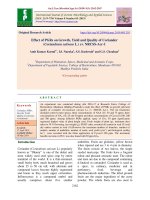
![Studies on correlation and path analysis for grain yield and quality components in foxtail millet [Setaria italica (L.) Beauv.]](https://media.store123doc.com/images/document/2020_01/09/medium_dyd1578574836.jpg)


